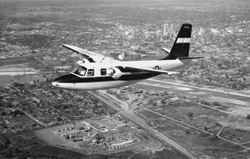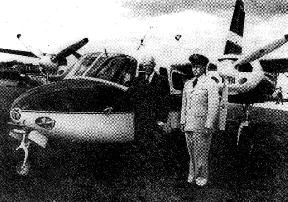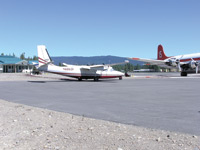Twin Commanders Pursue
Public Benefit Missions


A distinctive high-wing configuration, great visibility from the cockpit and passenger cabin, sturdy construction, responsive handling, and powerful engines are just some of the attributes that have attracted owner-pilots and business operators to Twin Commanders for more than half a century. Those qualities also appeal to another type of operator, one with particular interest in specialized utility roles. Be it county, state, federal, or even military agency, Twin Commanders have been working for the public benefit almost since they were first produced.
In fact, an early customer for what were then called Aero Commanders was the United States Air Force. According to Twin Commander historical records, on May 27, 1955, the USAF announced that it was purchasing 15 model 560A Aero Commanders from the factory in Bethany, Oklahoma. The military designation for the airplane was L-26B. (The Air Force subsequently changed its aircraft designations, and the L-26 became the U-4.)
A week later the Air Force determined that the Aero Commander met safety standards for transporting the President. An L-26B was assigned to President Dwight D. Eisenhower, who used it for short trips, including to a grass strip on the presidential farm in Gettysburg, Pennsylvania, just 70 miles north of Washington D.C.
In March 1956 Aero Commander delivered its first production 680 to the Air Force to replace President Eisenhower’s L-26B. It was designated then as the L-26C and later as the U-4B.
THE FIRST AIR FORCE ONE TWIN

After President Eisenhower left office the former Air Force One was used for transporting high-ranking government officials. On October 1, 1969, it was transferred to the Air Force Academy, where it was used for cadet parachute training and the Academy’s skydiving team. In November 1977 the U-4B was sent to the Nebraska Civil Air Patrol, and later ended up in an aircraft salvage yard.
When the owner of the yard, Bill Duff, was told of the airplane’s history, he restored it to airworthy condition in its Air Force One configuration and in 1996 donated it to the Air Force Museum. Today it is on display in the museum’s Presidential Gallery at Wright-Patterson Air Force Base in Dayton, Ohio.
Today Twin Commanders are involved in government and military work at all levels all around the world. Two large California counties, Kern and San Bernardino, are examples of how government agencies employ Twin Commanders in some unique applications.
Kern County took delivery of a new Grand Renaissance earlier this year. Its primary role is “air attack”—aerial command and control in fire-fighting missions. The Twin Commander loiters near a wildfire, and an air operations supervisor in the right seat directs air and ground forces in containing the blaze. The Kern County aircraft also is fitted with a station in the passenger cabin that allows a supervisor to oversee an operations supervisor trainee.
Scott Beck, one of the county’s air operations pilots, said the airplane has worked several fires so far this season, including the 16,000-acre Guiberson fire near Fillmore in Ventura County, and the 2,400-acre Cottonwod fire in Riverside County.
The Kern County air attack Grand Renaissance flew a pair of three-hour shifts on each fire, Beck said, directing a variety of fire bombers including McDonnell Douglas DC-10s, a Martin Mars, Lockheed P2Vs and P-3s, Grumman S2Ts, and a variety of helicopters.
AIR ATTACK MISSION

and performance.
The unobstructed visibility afforded by the high wing is an obvious attribute in the air attack role, but operators also cite single-engine safety, good handling at low indicated airspeeds, a stable ride in the often turbulent air around a wildfire, and fuel-efficiency as plusses.
The San Bernardino County Sheriff’s Office has been operating its Grand Renaissance Twin Commander for nine years, taking county officials to remote cities and towns throughout the huge county, California’s largest. The Grand Renaissance also is used to transport prisoners to and from other states, and on various other law enforcement-related missions.
Wayne Pliss, chief pilot for the sheriff’s department’s aviation unit, said he much prefers to fly the Grand Renaissance over the department’s King Air 200 because of its superior speed, full-fuel payload, fuel efficiency, and lower engine-overhaul costs. “Everything about it makes more sense,” Pliss says.
The State of Arizona took a 690B Twin Commander it had been operating for 15 years and had it completely refurbished as a Grand Renaissance Twin Commander. That was about 10 years ago. The state’s TPE331-10T-powered Grand Renaissance is fitted with a camera port in the belly, and is assigned to aerial photography missions. It also is used for passenger transport around the state. Pilots log as many as eight legs a day flying trips ranging from a few minutes to just over an hour.
SNOW SURVEYING

“The high wing is one reason we’ve had Commanders from the start,” explains LCDR David Demers, chief of the agency’s airborne snow survey program and one of several NOAA pilots who fly the missions. In addition to great visibility, the Commanders have “really good slow-flight characteristics,” Demers says. “We get up in a lot of valleys, and we never know if we might have to turn around.” The ability to maneuver the Commanders at slow speeds gives pilots the confidence they need to do the job.
In Mexico, a pair of 690B Twin Commanders operated by the Highways Agency in the Ministry of Communications and Transportation take turns overflying the Popocatepetl volcano southeast of Mexico City. The crews’ job is to fly at 23,000 feet and take photographs of the active volcano.
They’ve been doing it since 1994, and the photographic record provides a highly detailed history of the volcano’s mood throughout the years, and an early warning of a possible eruption. That early warning allows the government to alert the citizenry and evacuate people living near the volcano.
From Air Force One to volcano monitor, Twin Commanders are adapting to and excelling at a diverse range of public-benefit missions.
Discuss this article in the forums...







